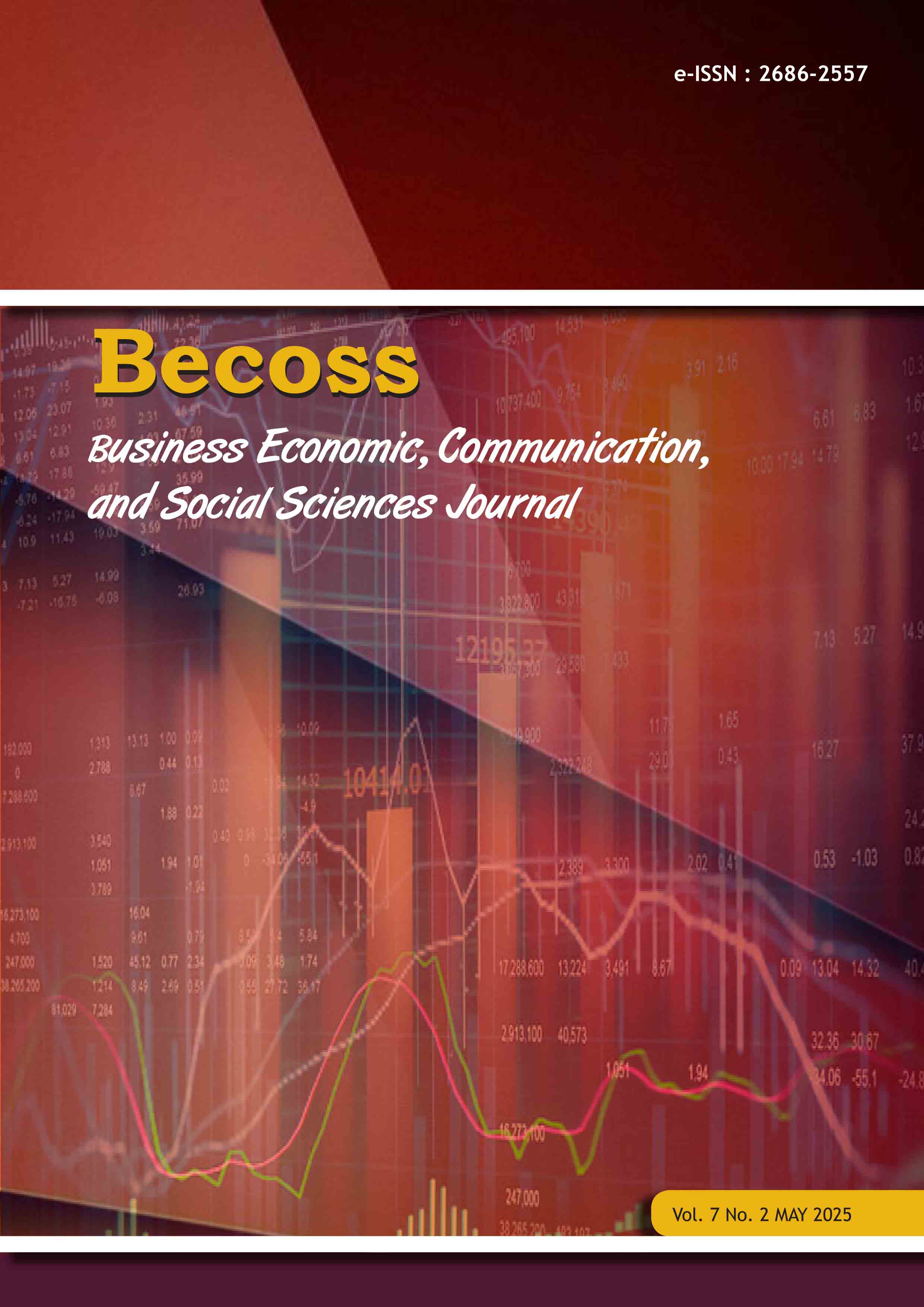Personality and Mental Well-Being of Adolescent Students from Dysfunctional Families: Basis for the Development of an Intervention Program
DOI:
https://doi.org/10.21512/becossjournal.v7i2.13497Keywords:
Family, Adolescents, Dysfunctional Family, Mental Well-Being, PersonalityAbstract
The family structure, including parents, marriage and children, is said to be the building block of society and the most basic form of social organisation, and so it should be a place where children grow up in good mental and physical health (although reality is often somewhat different). In dysfunctional families, young people may experience emotional suffering or instability and may not receive regular support from their family, which can affect their psychological development and future development. This research analyzed the association of personality traits with the mental health of adolescents from dysfunctional families in a quantitative manner based on personality traits and well-being levels, demonstrating a characteristic profile of high openness and agreeableness combined with relatively low conscientiousness, extraversion, and neuroticism. Of these, characteristics such as conscientiousness emerged as a robust predictor of mental well-being, suggesting that structure, self-control and goal directed behaviour may be particularly important to individuals’ resilience in the face of challenging family environments. The results bear on the possibility that developing conscientious habits may make adolescents more resistant to life’s tribulations and provide them greater equanimity. For these reasons, preventive interventions that involve parents and teachers and students themselves, and promote resilience, re-oriente coping strategies and positive parenting are advisable. Such interventions contribute not only to better family communication and mutual understanding, but to greater mental health among adolescents under difficult circumstances
References
Ainsworth, M. D. S. (1989). Attachments beyond infancy. American Psychologist, 44(4), 709–716. https://doi.org/10.1037/0003-066X.44.4.709
Al Ubaidi, B. A. (2017). Adult children of dysfunctional families. The Journal of Psychiatry, 20(1), 1–6. https://doi.org/10.4172/2378-5756.1000397
APA. (2022). Mental health. American Psychological Association. https://www.apa.org/topics/mental-health
Bandura, A. (1986). Social foundations of thought and action: A social cognitive theory. Prentice-Hall.
Baena, A., Gómez-López, M., Granero-Gallegos, A., & Martínez-Molina, M. (2021). Protective factors against family dysfunction in adolescence. International Journal of Environmental Research and Public Health, 18(2), 1–13. https://doi.org/10.3390/ijerph18020547
Bowlby, J. (1969). Attachment and loss: Vol. 1. Attachment. Basic Books.
Bowen Theory Academy. (2022). Bowen theory: Key concepts. https://www.thebowencenter.org
Branje, S. J., van Aken, M. A., & van Lieshout, C. F. (2002). Relational support in families with adolescents. Journal of Early Adolescence, 22(2), 188–219. https://doi.org/10.1177/0272431602022002003
Brown, B. (2021). Dysfunctional family dynamics and their effects. Psychology Today. https://www.psychologytoday.com
Campbell-Sills, L., Cohan, S. L., & Stein, M. B. (2006). Relationship of resilience to personality, coping, and psychiatric symptoms in young adults. Behaviour Research and Therapy, 44(4), 585–599. https://doi.org/10.1016/j.brat.2005.05.001
Caspi, A., Roberts, B. W., & Shiner, R. L. (2005). Personality development: Stability and change. Annual Review of Psychology, 56, 453–484. https://doi.org/10.1146/annurev.psych.55.090902.141913
Cohen, J. (1988). Statistical power analysis for the behavioral sciences (2nd ed.). Lawrence Erlbaum.
Cummings, E. M., Davies, P. T., & Campbell, S. B. (2014). Developmental psychopathology and family process: Theory, research, and clinical implications. Guilford Press.
Davis, D. (2019). What is mental well-being? Verywell Mind. https://www.verywellmind.com
Dykeman, B. (2014). Structured routines and adolescent behavior. Journal of Instructional Psychology, 41(2), 1–8.
Emery, R. (2013). Cultural perspectives on divorce. Oxford University Press.
Encyclopedia Pub. (2023). Conscientiousness as a predictor of resilience. Encyclopedia Publishing.
Evans, J. D. (1996). Straightforward statistics for the behavioral sciences. Brooks/Cole Publishing.
Eysenck, H. J., & Eysenck, M. W. (2016). Personality and individual differences: A natural science approach. Springer.
Garcia, A. S., & Alampay, L. P. (2013). Parental discipline, warmth, and psychological adjustment of Filipino adolescents. Philippine Journal of Psychology, 46(1), 1–30.
Graziano, W. G., & Tobin, R. M. (2015). Agreeableness. In M. Mikulincer, P. R. Shaver, M. L. Cooper, & R. J. Larsen (Eds.), APA handbook of personality and social psychology (Vol. 4, pp. 347–366). American Psychological Association. https://doi.org/10.1037/14344-016
Green, A. (2015). Children in divorce: Coping and development. Child and Adolescent Social Work Journal, 32(5), 419–430. https://doi.org/10.1007/s10560-015-0395-7
Greydanus, D. E., & Shek, D. T. (2009). The influence of family dysfunction on adolescents. International Journal of Adolescent Medicine and Health, 21(2), 199–209. https://doi.org/10.1515/IJAMH.2009.21.2.199
Gutiérrez, M., Jiménez, A. M., Hernández, E. G., & Puente, M. (2017). Personality and adolescent well-being. Journal of Adolescence, 56, 48–57. https://doi.org/10.1016/j.adolescence.2017.02.007
Hair, N. L., Hanson, J. L., Wolfe, B. L., & Pollak, S. D. (2015). Association of child poverty, brain development, and academic achievement. JAMA Pediatrics, 169(9), 822–829. https://doi.org/10.1001/jamapediatrics.2015.1475
Hill, P. L., & Roberts, B. W. (2016). Conscientiousness as a predictor of well-being. Current Directions in Psychological Science, 25(6), 1–8. https://doi.org/10.1177/0963721416659252
Hooper, L. M. (2007). Parentification in families. The Family Journal, 15(3), 217–223. https://doi.org/10.1177/1066480707301294
Jacob, M. C. (2013). Divorce in the Philippines. Asian Journal of Law and Society, 1(2), 1–10.
John, O. P., & Srivastava, S. (1999). The Big Five trait taxonomy: History, measurement, and theoretical perspectives. In L. A. Pervin & O. P. John (Eds.), Handbook of personality: Theory and research (2nd ed., pp. 102–138). Guilford Press.
Johnson, L., & Kelly, M. (2020). Family dysfunction and adolescent self-esteem. Journal of Child and Family Studies, 29(1), 112–125. https://doi.org/10.1007/s10826-019-01536-5
Johnson, P., & Green, C. (2019). Parenting and adolescent maladjustment. Journal of Adolescence, 73, 15–28. https://doi.org/10.1016/j.adolescence.2018.12.001
Jones, T., & Brown, R. (2021). Stress and conscientious adolescents. Child Development Research, 2021, 1–10. https://doi.org/10.1155/2021/784123
King University Online. (2020). What is a dysfunctional family? https://online.king.edu
Lamb, M. E., & Lewis, C. (2019). Family relationships and child development. Annual Review of Developmental Psychology, 1, 1–25. https://doi.org/10.1146/annurev-devpsych-121318-085101
Lanozo, A., Cruz, M., & Bautista, R. (2021). Filipino families in crisis: Psychological perspectives. Philippine Social Science Journal, 4(3), 45–58.
Lee, H. (2018). Dysfunctional families and adolescent personality. Journal of Child Psychology, 45(4), 225–237.
Lüdtke, O., Roberts, B. W., Trautwein, U., & Nagy, G. (2014). Longitudinal associations of personality traits with academic achievement. Journal of Personality and Social Psychology, 107(3), 799–816. https://doi.org/10.1037/a0036863
Martinez, J., & Reyes, P. (2021). Dysfunctional families and Filipino youth mental health. Asia Pacific Journal of Counseling and Psychotherapy, 12(2), 1–15.
Martin, R. (2022). The effects of dysfunctional parenting on adolescent development. Journal of Family Psychology, 36(5), 622–634.
Masten, A. S., Narayan, A. J., & Hostinar, C. E. (2014). Resilience in children and youth. Annual Review of Clinical Psychology, 10, 411–445. https://doi.org/10.1146/annurev-clinpsy-032813-153457
McCrae, R. R. (2018). Five-factor theory of personality. Annual Review of Psychology, 69, 161–182. https://doi.org/10.1146/annurev-psych-122216-011717
McCrae, R. R., & Costa, P. T. (1997). Personality trait structure as a human universal. American Psychologist, 52(5), 509–516. https://doi.org/10.1037/0003-066X.52.5.509
Miller, A., & Wilson, S. (2021). Parental conflict and adolescent well-being. Child Psychiatry and Human Development, 52(1), 1–14.
Minuchin, S. (1974). Families and family therapy. Harvard University Press.
Mischel, W., & Shoda, Y. (1995). A cognitive-affective system theory of personality. Psychological Review, 102(2), 246–268. https://doi.org/10.1037/0033-295X.102.2.246
Mphaphuli, S. (2023). Family dysfunction and adolescent mental well-being. Journal of Adolescent Research, 38(1), 1–15.
Nichols, M. P., & Schwartz, R. C. (2004). Family therapy: Concepts and methods (6th ed.). Allyn & Bacon.
Nickerson, A. (2016). Social learning and maladaptive behavior. Journal of Child and Family Studies, 25(1), 1–8.
Nunnally, J. C., & Bernstein, I. H. (1994). Psychometric theory (3rd ed.). McGraw-Hill.
Ormel, J., Jeronimus, B. F., Kotov, R., Riese, H., Bos, E. H., Hankin, B., & Oldehinkel, A. J. (2013). Neuroticism and common mental disorders. American Journal of Psychiatry, 170(9), 910–917. https://doi.org/10.1176/appi.ajp.2013.12121690
Peterson, C. (2018). Looking forward through the lifespan: Developmental psychology (7th ed.). Pearson.
Philippine Statistics Authority. (2022). Census of population and housing: 2020 results. https://psa.gov.ph
Roberts, B. W. (2014). Personality development and well-being. Annual Review of Psychology, 65, 541–566. https://doi.org/10.1146/annurev-psych-010213-115123
Rogers, C. (1959). A theory of therapy, personality, and interpersonal relationships. McGraw-Hill.
Rothon, C., Goodwin, L., & Stansfeld, S. (2011). Family dysfunction and adolescent depression. Social Psychiatry and Psychiatric Epidemiology, 46(7), 593–602. https://doi.org/10.1007/s00127-010-0217-4
Saikia, J. (2017). Dysfunctional families and their impact on children. International Journal of Humanities and Social Science Research, 3(4), 1–6.
Sbarra, D. A., Bourassa, K. J., & Manvelian, S. (2019). Divorce and health: Current trends and future directions. Psychosomatic Medicine, 81(8), 715–721. https://doi.org/10.1097/PSY.0000000000000738
Schwartz, O. (2022). Family dysfunction and adolescent risk behavior. Youth Studies Australia, 41(3), 10–22.
Selve, M. (2021). Breaking cycles of dysfunction. Counseling Today. https://ct.counseling.org
Sheeber, L. B., Hops, H., & Davis, B. (2007). Family processes in adolescent depression. Journal of Abnormal Child Psychology, 35(5), 729–740. https://doi.org/10.1007/s10802-007-9128-8
Smith, A. (2020). Parenting styles and adolescent adjustment. Journal of Family Studies, 26(4), 1–12.
Smith, K., Brown, T., & Harris, P. (2019). Conscientiousness and resilience in adolescents. Journal of Youth and Adolescence, 48(2), 1–14. https://doi.org/10.1007/s10964-018-0934-2
Soto, C. J., & John, O. P. (2017). The next Big Five Inventory (BFI-2): Developing and assessing a hierarchical model with 15 facets to enhance bandwidth, fidelity, and predictive power. Journal of Personality and Social Psychology, 113(1), 117–143. https://doi.org/10.1037/pspp0000096
Soto, C. J., & Tackett, J. L. (2015). Personality traits in childhood and adolescence. Current Directions in Psychological Science, 24(5), 358–362. https://doi.org/10.1177/0963721415589345
Steel, P., Schmidt, J., & Shultz, J. (2008). Refining the relationship between personality and subjective well-being. Psychological Bulletin, 134(1), 138–161. https://doi.org/10.1037/0033-2909.134.1.138
Steeger, C. M., & Gondoli, D. M. (2018). Mother–adolescent conflict and depressive symptoms. Journal of Family Psychology, 32(2), 229–239. https://doi.org/10.1037/fam0000364
Stewart-Brown, S., Tennant, A., Tennant, R., Platt, S., Parkinson, J., & Weich, S. (2007). Internal construct validity of the Warwick–Edinburgh Mental Well-being Scale (WEMWBS). Health and Quality of Life Outcomes, 5(1), 1–8. https://doi.org/10.1186/1477-7525-5-63
Strus, W., & Cieciuch, J. (2017). Towards a synthesis of personality, temperament, and emotions. Personality and Individual Differences, 119, 68–73. https://doi.org/10.1016/j.paid.2017.06.024
Szapocznik, J., & Prado, G. (2007). Negative family functioning and adolescent risk behavior. Family Process, 46(2), 1–15.
Tennant, R., Hiller, L., Fishwick, R., Platt, S., Joseph, S., Weich, S., Parkinson, J., ... & Stewart-Brown, S. (2007). The Warwick–Edinburgh Mental Well-being Scale (WEMWBS): Development and UK validation. Health and Quality of Life Outcomes, 5(1), 1–13. https://doi.org/10.1186/1477-7525-5-63
Thompson, M. (2016). Filipino families in transition. Philippine Journal of Psychology, 49(1), 1–18.
Tus, J. (2020). The impact of family relationship on the academic performance of students. International Journal of Research Publications, 58(1), 1–5. https://doi.org/10.47119/IJRP100581220201349
Utaminingtyas, A. (2021). Dysfunctional family and adolescent mental well-being. Asian Journal of Psychiatry, 62, 102736. https://doi.org/10.1016/j.ajp.2021.102736
Warwick Innovations. (2025). WEMWBS: Normative data. University of Warwick. https://warwick.ac.uk/fac/sci/med/research/platform/wemwbs
WHO. (2021). Adolescent mental health. World Health Organization. https://www.who.int/news-room/fact-sheets/detail/adolescent-mental-health
Wickrama, K. A. S., & Bryant, C. M. (2003). Community context of social resources and adolescent mental health. Journal of Marriage and Family, 65(4), 850–866. https://doi.org/10.1111/j.1741-3737.2003.00850.x
Ystgaard, M., Tambs, K., & Dalgard, O. S. (2003). Life stress, social support, and psychological distress in late adolescence. Journal of Adolescence, 26(6), 703–715. https://doi.org/10.1016/j.adolescence.2003.08.006
Zhang, Y., Liu, W., & Wang, H. (2023). Parenting, personality, and adolescent well-being. Journal of Youth and Adolescence, 52(7), 1421–1436. https://doi.org/10.1007/s10964-023-01678-2
Zisner, A. R., & Crandall, A. (2017). Personality and adolescent adjustment. Journal of Child and Family Studies, 26(10), 2837–2850. https://doi.org/10.1007/s10826-017-0771-4
Zitzman, S. T. (2019). Family dissolution and adolescent development in the Philippines. Journal of Family Issues, 40(14), 2075–2098. https://doi.org/10.1177/0192513X19849467
Downloads
Published
How to Cite
Issue
Section
License
Copyright (c) 2025 Limar T. Kisse

This work is licensed under a Creative Commons Attribution-ShareAlike 4.0 International License.
Authors who publish with this journal agree to the following terms:
- Authors retain copyright and grant the journal right of first publication with the work simultaneously licensed under a Creative Commons Attribution License - Share Alike that allows others to share the work with an acknowledgment of the work's authorship and initial publication in this journal.
- Authors are able to enter into separate, additional contractual arrangements for the non-exclusive distribution of the journal's published version of the work (e.g., post it to an institutional repository or publish it in a book), with an acknowledgment of its initial publication in this journal.
- Authors are permitted and encouraged to post their work online (e.g., in institutional repositories or on their website) prior to and during the submission process, as it can lead to productive exchanges, as well as earlier and greater citation of published work.
USER RIGHTS
All articles published Open Access will be immediately and permanently free for everyone to read and download. We are continuously working with our author communities to select the best choice of license options, currently being defined for this journal as follows: Creative Commons Attribution-Share Alike (CC BY-SA)






